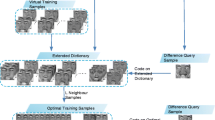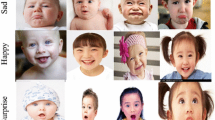Abstract
Facial expression recognition (FER) plays a significant role in human–computer interaction. However, in FER applications, the samples are usually corrupted by individual differences, which affect the classification result to some extent. This paper proposes an individual-free representation-based classification, which utilizes the variation training set (VTS) and the virtual variation training set (VVTS) to remit the side-effect caused by individual differences. The VTS and VVTS are both generated from the original training set and show possible variation of the expression. The new approach performs low-rank decomposition-based singular value decomposition for both VTS and VVTS, and then integrates them to determine the label of the query sample. This promising performance is mainly attributed to the fact that VTS and VVTS used in the proposed method can exploit limited original training set to produce a large possible expression variation. Experimental results show that the proposed method can achieve better performance than most of the competitive FER methods, e.g., SVM, SRC, CRC, LRC and the method in Lee et al.








Similar content being viewed by others
References
Li, X., Ruan, Q., An, G., Jin, Y., Zhao, R.: Multiple strategies to enhance automatic 3D facial expression recognition. Neurocomputing 161, 89–98 (2015)
Happy, S.L., Routray, A.: Automatic facial expression recognition using features of salient facial patches. IEEE Trans. Affect. Comput. 6, 1–12 (2015)
Shao, J., Gori, l, Wan, S., Aggarwal, J.K.: 3D dynamic facial expression recognition using low-resolution videos. Pattern Recognit. Lett. 65, 157–162 (2015)
Tariq, U., Thomas, J., Huang, T.S.: Supervised super-vector encoding for facial expression recognition. Pattern Recognit. Lett. 46, 89–95 (2014)
Maronidis, A., Bolis, D., Tefas, A., Pitas, I.: Improving subspace learning for facial expression recognition using person dependent and geometrically enriched training sets. Neural Netw. 24, 814–823 (2011)
Yurtkan, K., Demirel, H.: Feature selection for improved 3D facial expression recognition. Pattern Recognit. Lett. 38, 26–33 (2014)
Fukushima, K.: Increased Robustness Against Background Noise: Pattern Recognition by a Neocognitron, vol. 6444, pp. 574–581. Springer, Berlin (2010)
Luo, Y., Wu, C.M., Zhang, Y.: Facial expression recognition based on fusion feature of PCA and LBP with SVM. Optik 124, 2767–2770 (2013)
Siddiqi, M.H., Khan, A.M., Park, Y., Lee, S.: Human facial expression recognition using stepwise linear discriminant analysis and hidden conditional random fields. IEEE Trans. Image Process. 24, 1386–1398 (2015)
Wang, Z., Ying, Z.: Facial expression recognition based on local phase quantization and sparse representation. In: IEEE International Conference on Computer Science and Automation Engineering, vol. 2, pp. 440–444 (2012)
Yan, Q., Nong, S., Rui, H.: Robust automatic facial expression detection method based on sparse representation plus LBP map. Optik 124, 6827–6833 (2013)
Ruan, J., Yin, J., Chen, Q., Chen, G.: Facial expression recognition based on Gabor wavelet transform and relevance vector machine. J. Inf. Comput. Sci. 11, 295–302 (2014)
Wang, Q.W., Ying, Z.L.: Facial expression recognition algorithm based on Gabor texture features and Adaboost feature selection via sparse representation. Appl. Mech. Mater. Sens. Mechatron. Autom. 511, 433–436 (2014)
Liu, W., Song, C., Wang, Y., Jia, L.: Facial expression recognition based on gabor features and sparse representation. In: International Conference on International Conference on Control, vol. 43, pp. 1402–1406 (2012)
Wang, X., Ruan, Q., Jin, Y., An, G.: Expression robust three-dimensional face recognition based on Gaussian filter and dual-tree complex wavelet transform. J. Intell. Fuzzy Syst. 26, 193–201 (2014)
Lee, S.H., Plataniotis, K.N., Ro, Y.M.: Intra-class variation reduction using training expression images for sparse representation based facial expression recognition. IEEE Trans. Affect. Comput. 5, 340–351 (2014)
Li, L., Ying, Z., Yang, T.: Facial expression recognition by fusion of gabor texture features and local phase quantization. In: International Conference on Signal Processing Proceedings, vol. 1, pp. 1781–1784 (2015)
Zhong, S., Chen, Y., Liu, S.: Face expression using local feature selection and the extended nearest neighbor algorithm. In: International Symposium on Computational Intelligence and Design, vol. 1, pp. 328–331 (2014)
Mery, D., Bowyer, K.: Recognition of Facial Attributes Using Adaptive Sparse Representation of Random Patches. Lecture Notes in Computer Science, vol. 8926, pp. 778–792 (2015)
Ma, D., Li, M., Nian, F., Kong, C.: Facial expression recognition based on characteristics of block LGBP and sparse representation. J. Comput. Methods Sci. Eng. 15, 537–547 (2015)
Li, W., Du, Q., Xiong, M.: Kernel collaborative representation with tikhonov regularization for hyperspectral image classification. IEEE Geosci. Remote Sens. Lett. 12, 48–52 (2015)
Zhuo, L., Geng, Z., Zhang, J., Li, X.: ORB feature based web pornographic image recognition. Neurocomputing 173, 511–517 (2016)
Koc, M., Barkana, A.: Application of linear regression classification to low-dimensional datasets. Neurocomputing 131, 331–335 (2014)
Xu, Y., Zhang, Z., Lu, G., Yang, J.: Approximately symmetrical face images for image preprocessing in face recognition and sparse representation based classification. Pattern Recognit. 54, 68–82 (2016)
Wang, S.Z.: Sparse matrix of image denoising method based on SVD. Int. J. Multimedia Ubiquitous Eng. 9, 227–236 (2014)
Waqas, J., Zhang, Y., Lei, Z.: Collaborative neighbor representation based classification using l2-minimization approach. Pattern Recognit. Lett. 34, 201–208 (2013)
Liu, W., Lu, L., Li, H., Wang, W., Zou, Y.: A novel kernel collaborative representation approach for image classification. In: IEEE International Conference on Image Processing, pp. 4241–4245 (2014)
Lyons, M., Akamatsu, S., Kamachi, M., Gyoba, J.: Coding facial expressions with Gabor wavelets. In: IEEE International Conference on Automatic Face and Gesture Recognition, pp. 200–205 (1998)
Goeleven, E., De, Raedt R., Leyman, L., Verschuere, B.: The Karolinska directed emotional faces: a validation study. Cognit. Emot. 22, 1094–1118 (2008)
Tian, Y.: Evaluation of face resolution for expression analysis. In: Conference on Computer Vision and Pattern Recognition Workshop, pp. 82–82 (2004)
Acknowledgments
This work is supported by National Natural Science Foundation of China under Grant No. 61071199, Natural Science Foundation of Hebei Province of China under Grant No. F2016203422, Postgraduate Innovation Project of Hebei (China) under Grant No. 00302-6370011.
Author information
Authors and Affiliations
Corresponding author
Ethics declarations
Conflict of interest
The authors declare that there is no conflict of interests regarding the publication of this paper.
Rights and permissions
About this article
Cite this article
Sun, Z., Hu, Zp., Wang, M. et al. Individual-free representation-based classification for facial expression recognition. SIViP 11, 597–604 (2017). https://doi.org/10.1007/s11760-016-0999-x
Received:
Revised:
Accepted:
Published:
Issue Date:
DOI: https://doi.org/10.1007/s11760-016-0999-x




